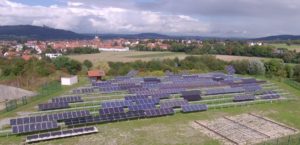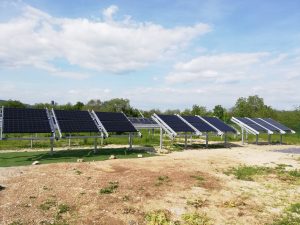 A walk through our test facility allows you to immerse yourself in the history of photovoltaics. Many previous generation modules , some already now a decade and a half old, show how technology has advanced. In our blog series, guest author and product manager René Schüler presents special test objects and reports in our latest contribution together with Manuel Baier about the latest system at our facility. In addition to the previous crystalline poly- and mono- solar modules, so-called bifacial modules have now also been inspected at the open-space test facility.
A walk through our test facility allows you to immerse yourself in the history of photovoltaics. Many previous generation modules , some already now a decade and a half old, show how technology has advanced. In our blog series, guest author and product manager René Schüler presents special test objects and reports in our latest contribution together with Manuel Baier about the latest system at our facility. In addition to the previous crystalline poly- and mono- solar modules, so-called bifacial modules have now also been inspected at the open-space test facility.
Bifacial solar modules also actively use the back of the module to supply electricity in addition to the irradiation on the front side (monofacial). Due to this design, bifacial PERC modules generate approximately 0.60% of the front side power under standard conditions with their rear side. Literally speaking it is called a bifacial coefficient. As part of the research at our test facility, we focused on the influences such as albedo and angle of inclination. The heights of support for bifacial solar modules were also examined. Albedo refers to the retroreflective power of a non-self-luminous, diffusely reflecting surface.
Preparations and first results

The existing open-space mounting concepts of our test system are dotted with the backs of bifacial modules. Due to their cross braces, special mounting systems were used on our facility. The resulting prototype fulfilled all conditions. In addition, new cable channels and new inverters were purchased and commissioned at the same time. This guaranteed the identical installation of the examination systems.
Previous research results have shown that with the same surface usage and mounting conditions, PERC bifacial solar modules allow for an extra yield of ~ 9% over mono PERC modules. In a direct comparison of the various soils tested “standing soil”, “main gravel” and “artificial grass” (as a substitute for natural grass), the influence of the albedo on the additional yield was less than one percent. The fact that the albedo of many types of soil only move between the values 0.18 to 0.24 has a minor effect on the surplus yield. Thus only a small change is expected or none at all.
A question of orientation
In order to find out which orientation of bifacial solar modules provides the highest possible additional yield, the system was tested in various variations on our test facility during the summer months of 2019. In this context, the different inclination angles in south orientation were 20/25/30/35/40 and 50°. The best result in terms of additional yield was achieved with a solar module inclination angle of 20° of 1.74 %. This result also allows the first tendencies for an ideal elevation in the winter months. In this respect, we expect a steeper elevation due to the low position of the sun.
What are the values like for bifacial modules with an east / west orientation? You may be curious. Our next article in this blog series will tell you. By the way: You can get an overview of our entire module portfolio here
Manuel Baier / René Schüler
Read more:
Part I: Polycrystalline modules through the ages
Part II: Visual error images
Part III: Performance measurement
Government should invest more and more in solar companies for research and development. The more they research, the better we can use those technologies. Thanks for writing about this.